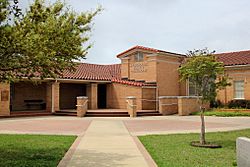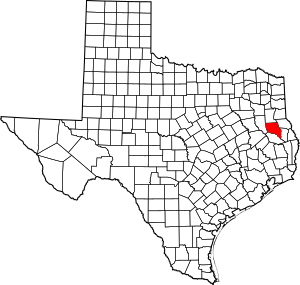Nacogdoches County, Texas facts for kids
Quick facts for kids
Nacogdoches County
|
|
|---|---|

The Nacogdoches County Courthouse
|
|

Location within the U.S. state of Texas
|
|
 Texas's location within the U.S. |
|
| Country | |
| State | |
| Founded | 1837 |
| Named for | Nacogdoche people |
| Seat | Nacogdoches |
| Largest city | Nacogdoches |
| Area | |
| • Total | 981 sq mi (2,540 km2) |
| • Land | 947 sq mi (2,450 km2) |
| • Water | 35 sq mi (90 km2) 3.5% |
| Population
(2020)
|
|
| • Total | 64,653 |
| • Density | 65.91/sq mi (25.446/km2) |
| Time zone | UTC−6 (Central) |
| • Summer (DST) | UTC−5 (CDT) |
| Congressional district | 17th |
Nacogdoches County (pronounced NAK-ə-DOH-chiss) is a county located in the state of Texas, USA. In 2020, about 64,653 people lived here. The main city and county seat is Nacogdoches. This county is part of the Nacogdoches micropolitan area.
Nacogdoches County is famous for its blueberries! It's the top blueberry producer in Texas. The county even hosts a fun Blueberry Festival every June. It calls itself the "Capital of the Texas Forest Country" because of its many forests.
Contents
History
Nacogdoches County was first created in 1826. Back then, it was a municipality of Mexico. Later, in 1837, it became an official county in Texas.
Geography
Nacogdoches County covers a total area of about 981 square miles. Most of this area is land. About 35 square miles, or 3.5%, is covered by water.
Neighboring Counties
Nacogdoches County shares its borders with several other counties:
- Rusk County to the north
- Shelby County to the northeast
- San Augustine County to the southeast
- Angelina County to the south
- Cherokee County to the west
Protected Natural Areas
Part of the Angelina National Forest is located within Nacogdoches County. This is a special area protected for nature and wildlife.
Population and People
The population of Nacogdoches County has changed a lot over the years.
| Historical population | |||
|---|---|---|---|
| Census | Pop. | %± | |
| 1850 | 5,193 | — | |
| 1860 | 8,292 | 59.7% | |
| 1870 | 9,614 | 15.9% | |
| 1880 | 11,590 | 20.6% | |
| 1890 | 15,984 | 37.9% | |
| 1900 | 24,663 | 54.3% | |
| 1910 | 27,406 | 11.1% | |
| 1920 | 28,457 | 3.8% | |
| 1930 | 30,290 | 6.4% | |
| 1940 | 35,392 | 16.8% | |
| 1950 | 30,326 | −14.3% | |
| 1960 | 28,046 | −7.5% | |
| 1970 | 36,362 | 29.7% | |
| 1980 | 46,786 | 28.7% | |
| 1990 | 54,753 | 17.0% | |
| 2000 | 59,203 | 8.1% | |
| 2010 | 64,524 | 9.0% | |
| 2020 | 64,653 | 0.2% | |
| U.S. Decennial Census 1850–2010 2010 2020 |
|||
In 2020, the county had 64,653 residents. The people living in Nacogdoches County come from many different backgrounds. This makes the community diverse and interesting.
Transportation
Getting around Nacogdoches County is possible by bus and major highways.
Bus Services
Greyhound Lines offers bus services from the Nacogdoches Station. This station is shared with the Kerrville Bus Company.
Main Highways
Several important highways pass through Nacogdoches County:
 U.S. Highway 59
U.S. Highway 59
 U.S. Highway 259
U.S. Highway 259 State Highway 7
State Highway 7 State Highway 21
State Highway 21 State Highway 103
State Highway 103 State Highway 204
State Highway 204 Farm to Market Road 95
Farm to Market Road 95 Farm to Market Road 225
Farm to Market Road 225 Farm to Market Road 226
Farm to Market Road 226
Communities
Nacogdoches County has several cities and smaller communities.
Cities
- Appleby
- Chireno
- Cushing
- Garrison
- Nacogdoches (This is the largest city and the county seat.)
Census-Designated Place
Unincorporated Communities
These are smaller towns and areas that are not officially part of a city:
Education
Students in Nacogdoches County attend various school districts:
- Central Heights Independent School District
- Chireno Independent School District
- Cushing Independent School District
- Douglass Independent School District
- Garrison Independent School District
- Martinsville Independent School District
- Nacogdoches Independent School District
- Woden Independent School District
For higher education, the county is part of the district for Angelina College. The Etoile Independent School District used to serve parts of the county, but it joined with Woden ISD in 2022.
Notable People
Some well-known people have lived in Nacogdoches County:
- Clint Dempsey, a famous professional soccer player.
- John H. Hannah Jr., who was a judge for the U.S. District Court.
- Ron Raines, an actor.
See also
 In Spanish: Condado de Nacogdoches para niños
In Spanish: Condado de Nacogdoches para niños

